Round a number in Excel (ROUND function)
The following article shows you how to round numbers in Excel, which helps to calculate faster
Depending on how to round the number of digits after and before the comma, there are many number rounded functions in Excel.
1. Round a number using the ROUND () function
- Meaning: Round to the nearest number according to the number of digits to round
- Syntax: ROUND (number, num_digits)
Inside:
+ number is the value to be rounded.
+ num_digits is the value to be rounded. If:
num_digits = 0 => rounds to the nearest integer
num_digits> 0 => rounds to the number of decimal places corresponding to the num_digits value
num_digits = 0 => rounds to the number of integer numbers corresponding to the num_digits value
- Example: Do the rounding of numbers in the table below using the round function
In a cell to calculate enter the formula: = ROUND (D7, E7)

Press Enter -> copy the formula for the remaining values to result:
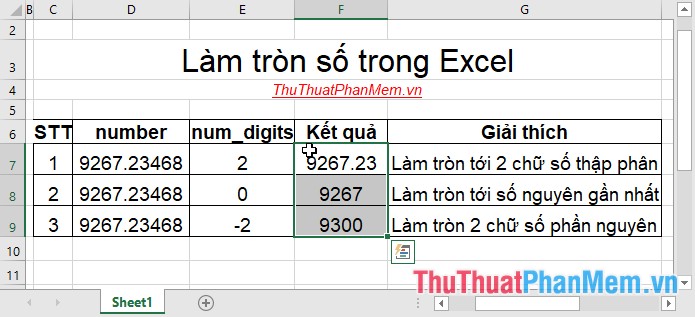
2. Round a number using the MROUND () function
- Meaning: Round to a multiple of a specified number
- Syntax: MROUND (nunber, multiple)
Inside:
+ number is the value to be rounded
+ multiple: Number to determine the multiple to round to
- Attention:
+ MROUND function is rounded far away from zero if the balance after dividing the number by multiple is greater than or equal to half the value of multiple
+ The argument, argument must be same if not returning #NUM error value
- Example: Round the following values using the MROUND () function
In a cell to calculate, enter the formula: = MROUND (D7, E7)
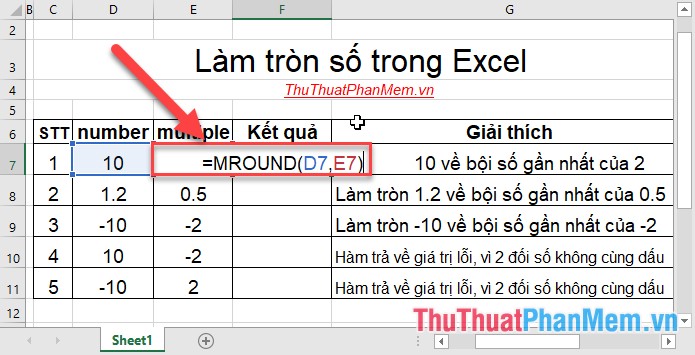
Press Enter -> copy the formula for the remaining values to result:
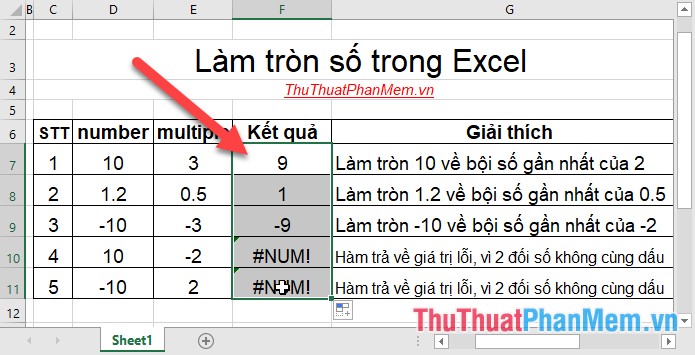
3. Round numbers using ROUNDDOWN () and ROUNDUP ()
- Meaning: The use of two similar functions is different:
+ ROUNDDOWN () function always rounds a number in the direction approaching zero
+ ROUNDDOWN () function always rounds a number in the direction going far away from 0
- Syntax:
ROUNDDOWN (number, num_digits)
ROUNDUP (number, num_digits)
Inside:
- number is the value to be rounded
- num_digits: number of digits to round. If:
num_digits = 0 => rounds to the nearest integer
num_digits> 0 => rounds to the number of decimal places corresponding to the num_digits value
num_digits = 0 => rounds to the number of integer numbers corresponding to the num_digits value
- For example:
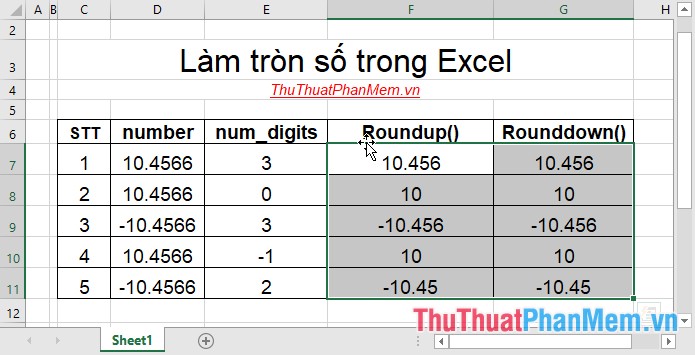
4. Rounding numbers using CEILING () and FLOOR ()
4.1 CEILING function
Description: The function performs rounding up, away from 0 to the nearest significant multiple.
Syntax: CEILING (number, significance) .
Inside:
- number: The value you want to round, is a required parameter.
- significance: The multiple you want to round, is a required parameter.
Attention:
- If the arguments in the function are not numbers -> the function returns the #VALUE! Error value
- The value rounded up is adjusted away from zero despite the sign of the number is negative. If number is the correct set of significance, do not round it.
- If the number is a negative value and the negative level the value is rounded down away from zero.
- If the number is a negative value and the positive level the value is rounded up to 0.
For example:
Round the values in the following table with multiples in the description:
In a cell to calculate enter the formula: = CEILING (C8, D8)
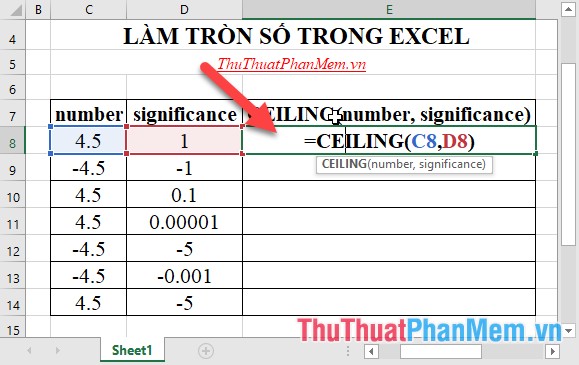
Press Enter and copy the formula for the remaining values to get the result:
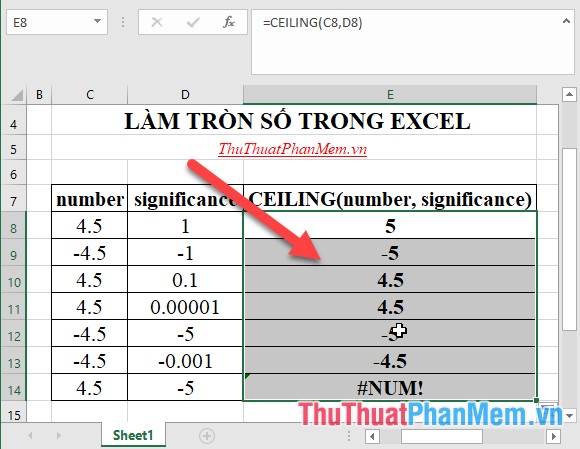
4.2 FLOOR function
The Floor function is similar to the Ceiling function, except that the Floor function rounds down to zero.
5. Rounding numbers using the EVEN () and ODD () functions
- The Even () function is a function that rounds numbers up to the nearest even integer
Syntax: EVEN (number)
Where: number is the value you want to round
- Odd () is a function that rounds numbers up to the nearest odd integer
Syntax: ODD (number)
Where: number is the value you want to round
Example: Rounding the following values by using the even () and odd () functions
In the cell to calculate the value of doing in the Even function enter the formula: = EVEN (B7)
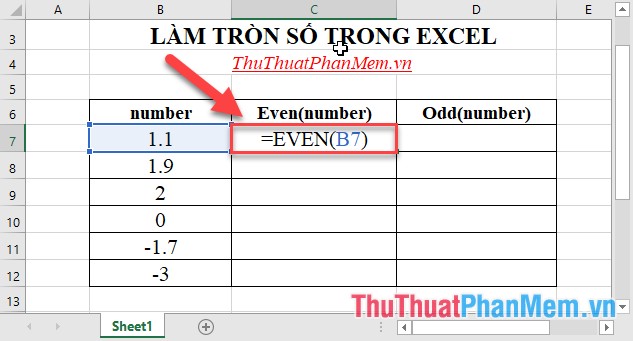
Press Enter -> copy the formula for the remaining values to result:
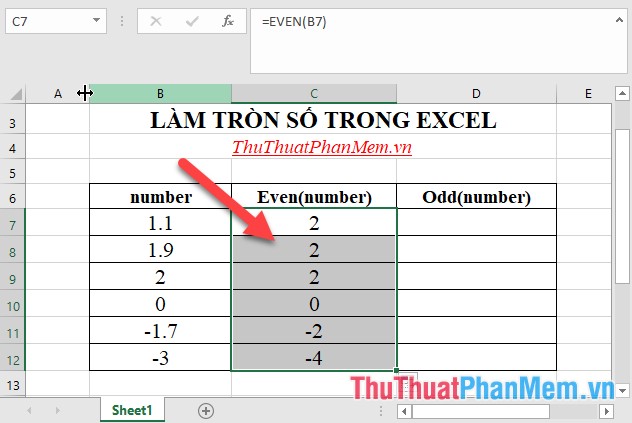
Similarly in the cell to calculate the rounding value according to Odd (), enter the formula: = ODD (B7)
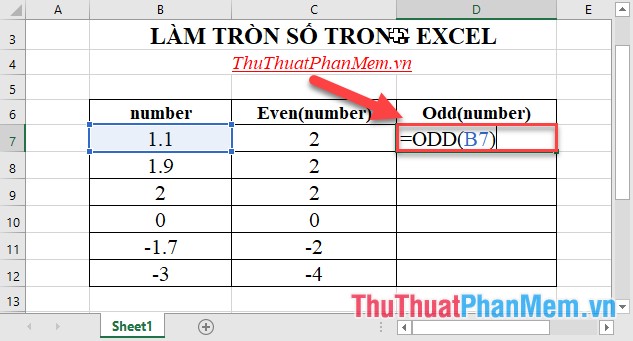
Press Enter -> copy the formula for the remaining values to result:
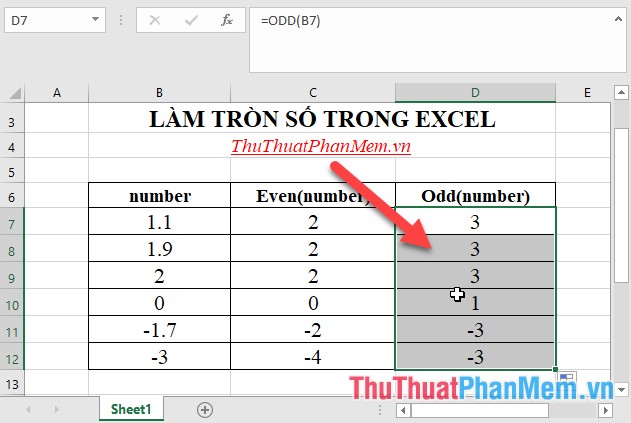
6. Round numbers using the INT () and TRUNC () functions
- INT function performs rounding down to the nearest integer.
Syntax: Int (number)
Where: number is the value to be rounded
- The function Trunc performs rounding according to the number of decimal places
Syntax: TRUNC (number, [num_digits])
Inside:
- number is the value to be rounded
- num_digits: is the number of decimal places to be rounded, is an optional parameter with a default value of 0.
For example:
In a cell to calculate rounding value according to Int function, enter the formula: = INT (B7)
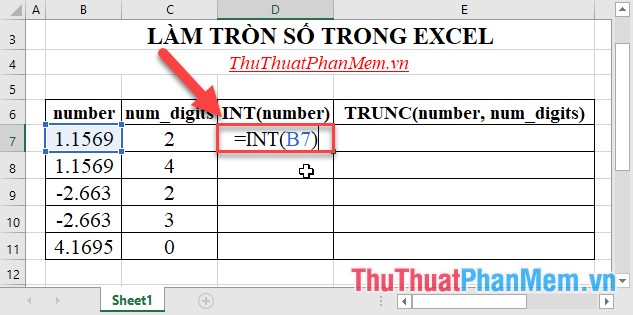
Press Enter -> copy the formula for the remaining values to result:
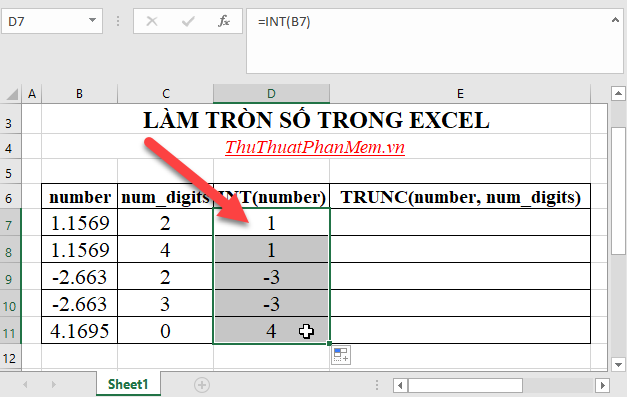
In the cell to calculate rounding value according to the Trunc function enter the formula: = Trunc (B7)
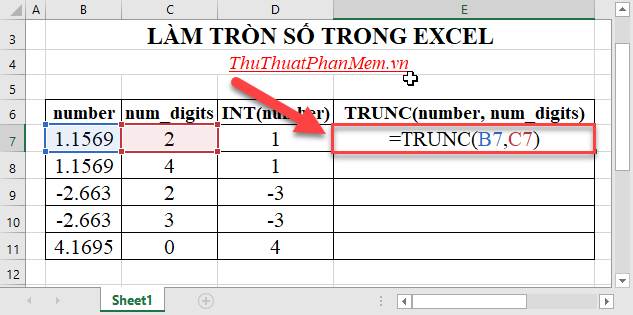
Press Enter -> copy the formula for the remaining values to result:
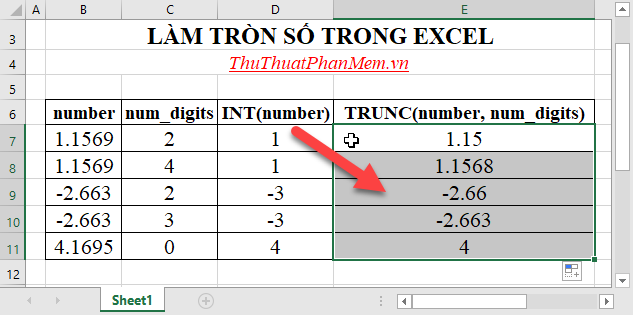
The above is a detailed guide on how to round numbers in Excel in various ways using Excel functions. Good luck!
You should read it
- ROUND function in SQL Server
- Ways to round numbers in Excel
- Round function (rounding) in Excel
- How to round numbers in Excel using the ROUND, ROUNDUP, ROUNDDOWN Function
- Instructions on how to use the ROUND function in excel
- How to Round in Excel
- How to round time to 30 minutes or 15 minutes in Excel
- ROUNDUP function in Excel - Usage and examples
May be interested
- PERMUT function - The function returns the number of permutations of a given number of objects in Excel
 permut function: the function returns the number of permutations of a given object. permutations are subsets of values where the position and number of elements in permutations are different. syntax: permut (number, number_chosen)
permut function: the function returns the number of permutations of a given object. permutations are subsets of values where the position and number of elements in permutations are different. syntax: permut (number, number_chosen) - DATE Function: Converts numbers to a valid date format
 the date function in excel is a useful and most commonly used function. let's learn how to use the date function in excel with tipsmake.com.com!
the date function in excel is a useful and most commonly used function. let's learn how to use the date function in excel with tipsmake.com.com! - COUPNUM function - The function returns the number of interest payments on a security in Excel
 in the process of investing in securities, paying special interest is very important. it helps you calculate and plan a reasonable calculation and investment. the following article details the coupnum function - the function returns the number of interest payments of securities in excel.
in the process of investing in securities, paying special interest is very important. it helps you calculate and plan a reasonable calculation and investment. the following article details the coupnum function - the function returns the number of interest payments of securities in excel. - PI (PI Function) in Excel - How to use PI numbers in Excel
 pi (pi function) in excel - how to use pi numbers in excel. pi number is a mathematical constant with an approximate value of 3,1415926535897 ... we can find pi numbers in many trigonometric and geometric formulas. especially the formulas related to circles, ellipses, and spheres:
pi (pi function) in excel - how to use pi numbers in excel. pi number is a mathematical constant with an approximate value of 3,1415926535897 ... we can find pi numbers in many trigonometric and geometric formulas. especially the formulas related to circles, ellipses, and spheres: - How to use the LEN function in Excel
 the len function in excel is used to measure the length of a certain string of characters, including spaces and correctly return the total character for the user.
the len function in excel is used to measure the length of a certain string of characters, including spaces and correctly return the total character for the user. - The DAYS function - The function returns the number of days between 2 dates in Excel
 days function: the function returns the number of days between 2 dates, the support function from excel 2013 onwards. syntax: days (end_date, start_date)
days function: the function returns the number of days between 2 dates, the support function from excel 2013 onwards. syntax: days (end_date, start_date) - DAYS function, how to use the function to calculate the number of days between two time points in Excel
 the days function in excel returns the results between two different timelines.
the days function in excel returns the results between two different timelines. - Instructions on how to count words in cells in Excel
 in many cases you want to count the number of characters in a text string (text string) to calculate or combine with other functions, or to do something. you can then use the trim function, combining the len function, the substitute function. using the trim function to remove spaces, use the substitute function to replace the current text with new text in a text string, ...
in many cases you want to count the number of characters in a text string (text string) to calculate or combine with other functions, or to do something. you can then use the trim function, combining the len function, the substitute function. using the trim function to remove spaces, use the substitute function to replace the current text with new text in a text string, ... - DATEDIF function - The function calculates the number of days, months, years between 2 dates in Excel
 datedif function: the function performs the calculation of number of days, months, years between 2 dates in excel. functions are useful in formulas for calculating age numbers. syntax: datedif (start_date, end_date, unit)
datedif function: the function performs the calculation of number of days, months, years between 2 dates in excel. functions are useful in formulas for calculating age numbers. syntax: datedif (start_date, end_date, unit) - How to automate Vlookup with Excel VBA
 vlookup is an essential function in excel and has become an important part of data processing. it provides a number of functions that you can combine with a comprehensive database.
vlookup is an essential function in excel and has become an important part of data processing. it provides a number of functions that you can combine with a comprehensive database.










 How to reduce the size of Excel files
How to reduce the size of Excel files Instructions for page numbering in Word, align page numbers, delete page numbers
Instructions for page numbering in Word, align page numbers, delete page numbers COVARIANCE.P function - The function returns the covariance of a set, the product of the average of degrees of instruction for each pair of data points in Excel
COVARIANCE.P function - The function returns the covariance of a set, the product of the average of degrees of instruction for each pair of data points in Excel COVARIANCE.S function - Returns the covariance pattern, the average of product deviations for each pair of data points in two data sets in Excel
COVARIANCE.S function - Returns the covariance pattern, the average of product deviations for each pair of data points in two data sets in Excel INTERCEPT function - The function returns the point at which the line will intersect the y-axis by using the existing x and y values in Excel
INTERCEPT function - The function returns the point at which the line will intersect the y-axis by using the existing x and y values in Excel MODE.SNGL function - Function that returns the most frequently occurring, or the most repeated values in an array or data range in Excel
MODE.SNGL function - Function that returns the most frequently occurring, or the most repeated values in an array or data range in Excel